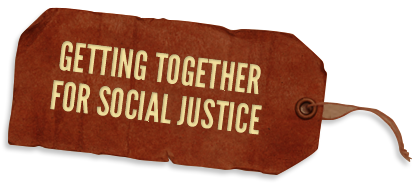IT IS IMPORTANT TO BEGIN ANY DISCUSSION OF DIVERSITY by thinking about how we got to this point where diversity is an issue.
After all, we have always been a diverse country. For hundreds of years we have been a mix of Native American, African American, Latino/a, Asian American, European American, all living together and contributing to our culture and history. We have been women and men, lesbian, gay, bisexual, and transgender, people with differing abilities, Jews, Christians, Muslims, and Buddhists living together. The United States has always contained multitudes. But it was with the advent of the Civil Rights Movement, the women’s liberation movement, and various other movements for social change that confronted the institutions of our society on their exclusionary practices and policies, that there arose a concern about diversity.
The diversity movement is the result of the struggles of disenfranchised groups for access to decision-making power, and access to resources, safety, and protection from exploitation, violation, and abuse. Diversity is therefore about more than cultural awareness, prejudice, and short term or superficial attempts to address “difference.” In other words, the question we should be asking ourselves is not “Can we all get along?” but “Can we all share power, resources, and opportunity?”
The first step in diversity work is assessment—determining who has access to power and resources, who is safe and who isn’t, who participates and who doesn’t. Is your school accessible? The only way to know is to ask a group of people with differing abilities to do an assessment of physical access. Is your school safe for lesbian, gay, bisexual and transgender students and faculty? You’ll have to ask them and do a systematic assessment of the school environment including classroom practices, the curriculum, the composition and retention of the teaching and administrative staff, the impact of tracking, discipline policies, funding, extracurricular activities and other areas of school programming, policies and procedures.
Each of these areas should be suspected of undermining efforts at diversity. For example, in terms of racism, national studies continue to show that less money is spent on the education of students of color than on white students, that students of color are disciplined more quickly and more harshly than white students for the same behavior, that academic tracking systematically channels students of color into lower levels of achievement, that the teaching pool is actually becoming more white even though the student body contains rapidly increasing numbers of students of color, and that most curricula fail to adequately reflect the contributions and achievements of people of color.
All of these factors have a direct impact on student achievement. Students feel that impact in their daily experiences with each other and with the adults around them. One way to involve students is to engage them in conducting a survey of students and faculty about the climate at the school. The ERASE project of the Applied Research Center in Oakland, CA, offers a broad instrument for schools to assess racism using institutional data that is very useful for pinpointing how racism operates in a school or school district.
After conducting an assessment you will probably find that there is work to do in such areas as: student and faculty attitudes and behaviors, classroom practice, school policies and procedures, curriculum, faculty and staff hiring and retention, training, and school climate. Task forces can be initiated to begin to analyze and make recommendations in each of these areas.
In general, I think that diversity work does not move forward unless there is strong leadership from the school administration, and substantial participation and commitment from students, faculty, parents, and staff to sustain a long-term process of change in how the school operates.
Other necessary components for serious diversity work include :
- A leadership group, representing all constituencies, that has the power to initiate change
- A process that is systematic and sustained, deep and thorough
- The dedication of adequate resources including money, staff release time, space, administrative support, and technical assistance
- A mission statement in which creating a diverse, multicultural community has to be seen as integral to the work of the school.
- Students need to be involved at all levels of the process.
- There must be specific goals and timetables so that individuals and the institution can be held accountable for achieving the desired goals.
Clearly, diversity work in schools is complex, multilayered, multilevel, and multi issue. This work takes leadership, time, and resources. You can provide the leadership. There is no time like the present. And most schools already have connections through staff, students, parents, and the wider community to the experience, resources, interest, and knowledge necessary to push such efforts forward. There are many books, websites, and consultants to support in-house efforts. Now is the only right time to begin. Pull together a diversity, multicultural, or human relations committee consisting of teachers, staff, students and parents. Begin or strengthen the process of building an inclusive, safe, multicultural school community in which fairness, justice, and equal opportunity are the norm.
Resources
ERASE (Eliminate Racism and Advance School Equity) at the Applied Research Center
510-653-3415
GLSEN (Gay, Lesbian and Straight Education Network)
800-247-6553
Seed Project and Stone Center publications
781-283-2500
WEEA Equity Resource Center
800-225-3088
Teaching for Change catalogue and newsletter from NCEA
800-763-9131
Rethinking Schools magazine and books
800-669-4192
In addition, check the catalogues of books from:
Redleaf Press
800-423-8309
Association for Supervision and Curriculum Development
800- 933-2723
New Society Publishers
800-567-6772
Teachers College Press
800-575-6566
Hunter House
800-266-5592
Jossey-Bass
800-956-7739
Allyn and Bacon
800-278-3525
Please send comments, feedback, resources, and suggestions for
distribution to paul@paulkivel.com. Further resources are
available at www.paulkivel.com.
All articles may be quoted, adapted, or reprinted only for noncommercial purposes and with an attribution to Paul Kivel, www.paulkivel.com. Creative Commons Attribution – Noncommercial 3.0 United States License. To view a copy of this license, visit here.
